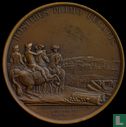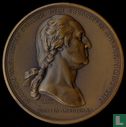

Enlarge image
USA Washington Before Boston 1776


Catalogue information
LastDodo number
5659561
Area
Tokens / Medals
Title
USA Washington Before Boston 1776
Publisher
Value
Country
Year
1776
Collection / set
Material
Weight
Variety / overstrike
Obverse
HOSTIBUS PRIMO FUGATIS BOSTONIUM RECUPERATUM XVII MARTII MDCCLXXVI
Reverse
COMITIA AMERICANA GEORGIO WASHINGTON SVPREMO DVCI EXERCITVVM ADSERTORI LIBERTATIS
Privy mark
Mint mark
Designer
Engraver
Dimensions / Diameter
68 mm
Number
Details
Mass: 134 grams
COMITIA AMERICANA GEORGIO WASHINGTON SVPREMO DVCI EXERCITVVM ADSERTORI LIBERTATIS (Latin) =
The American Congress
George Washington, Supreme Commander of the Army, Champion of Freedom
HOSTIBUS PRIMO FUGATUS BOSTONIUM RECUPERATUM XVII. MARTII MDCCLXXVI (Latin) =
The Enemy for the First Time Put to Flight Boston Retaken March 17, 1776
The first military medals of the USA.
The Early History of the Medal and the Comitia Americana Series
One of the more encouraging early victories during the Revolutionary War was the British evacuation of Boston on March 17, 1776. During the harsh winter months the former proprietor of the London Book Store on Cornhill in Boston and now Army Colonel, Henry Knox, transported fifty-nine canons and mortars from the recently captured Forts at Crown Point and Ticonderoga in western New York to Boston. As soon as this heavy artillery arrived, Washington mounted the canons on Dorchester Heights overlooking the city. Under the threat of bombardment the British troops fled to Halifax, making Boston the first major city liberated from British occupation. Eight days later, on March 25, 1776, the Continental Congress authorized a gold medal to commemorate this event and appointed a committee of John Adams, John Jay and Samuel Hopkins to prepare a letter of thanks to Washington and to select an appropriate devise for the medal.
On August 14 John Adams wrote to his wife Abigail that the previous day he had consulted with the artist Pierre DuSimitièrer in Philadelphia, who had prepared sketches for the Washington medal (his design for the obverse survives in the Library Company of Philadelphia). On November 29 the Treasury Committee of the Congress authorized a payment to DuSimitièrer of thirty-two dollars "for designing, making and drawing a medal for George Washington." Unfortunately, there are no further surviving records regarding this project. Subsequently, Congress authorized several other medals to commemorate military successes over the next three years, but it seems nothing more happened regarding their production. Finally, on July 27, 1779, after three years of inactivity, the Continental Congress, frustrated with the delays, reassigned the task of striking the medals to the Treasury Board, resolving the medals "to be struck without delay." It seems the board quickly realized that due to the war effort it was impossible to obtain the talent and resources in Philadelphia required for the minting of the medals. On September 29, 1779, Robert Troup, Secretary of the Treasury Board wrote to Benjamin Franklin, who was an American Commissioner in Paris, empowering him to supervise and expedite the project. Troup explained, "The impractibility of executing the work in this part of the World obligates the Board to forward them to you with an earnest request to have the Medals voted [by Congress] struck as soon as possible…" (quoted in Adams and Bentley, p. 232). By this time Congress had authorized six medals, one for Washington at Boston, another for Gates at Saratoga, three for valor during the assault on Stony Point, July 15, 1779 (Fleury, Wayne and Steward) and one for Henry Lee at the Battle of Paulus Hook. Troup further explained to Franklin that Lieutenant Colonel François-Louis Teissèdre de Fleury would be arriving in France to present him with a duplicate copy of the commission and that Fleury may be useful in assisting Franklin with the medals. Fleury did indeed meet with Franklin and requested that his own medal be expedited so that he could receive it before his leave was over and he was required to return to the army. Indeed, on January 29, 1780 Franklin responded to a request from Fleury that his medal be struck with the next week, stating that he had not yet even identified an artist who could produce it! With Fleury asking for some immediate results, Franklin of necessity began by working on that medal, which was completed by August 1780. However, the cost was high, Franklin stated that each die cost 1,000 livres.
With an eye to frugality Franklin decided to save money on the two other Stony Point medals, for Anthony Wayne and John Stewart, by using the same design on all three. Franklin simply had some of the Fleury medals altered by simply changing the name on the medals. This solution was an attempt to accelerate medal production at minimal cost, but the result was not a satisfactory product to award to the American patriots, so new medals were commissioned at a later date. In his letter of August 10, 1780 to Troup, where Franklin mentioned the Stony Point medals were completed, he requested that the Treasury Board supply him with "the Devices proper for the Other medals, the Difficulty of pleasing myself with regard to them occasioning some Delay." Franklin never received a reply to this request and he soon lost interest in the Congressional medal series. He did not take up medal production again until August of 1782, when he undertook a personal venture, to produce the Libertas Americana medal commemorating the victories at York and Saratoga. The medal was completed by late March or early April 1783 and celebrated France's assistance to America on the reverse by depicting an allegory of Minerva wielding a spear and holding a shield decorated with the fleurs–de-lis (France), protecting the infant Hercules (America) from an attacking lion (Britain).
Since the Congressional medals were once again put on the back burner, Congress decided to reassign the responsibility for the Comitia Americana series to a new commissioner, David Humphreys, who arrived in Paris in September 1784. In 1787 Humphreys produced the Horatio Gates and Nathaniel Greene medals. Following Humphreys' departure from France in November 1785, Thomas Jefferson accepted responsibility for the medals on May 7, 1786. Work began in earnest in early 1789 on the medals for Daniel Morgan and John Paul Jones (by Augustin Dupré); Washington before Boston, William Washington and John Howard (by Duvivier) and then on original medals for Anthony Wayne and John Stewart (by Nicolas-Marie Gatteaux). Nine of the eleven Comitia Americana medals were produced by the time Jefferson departed Paris for America on September 27, 1789, with the John Paul Jones medal delivered to Jefferson, in America, by December 15, 1789. The Henry Lee medal was produced in Philadelphia, because Lee's name had been inadvertently dropped from the list that Franklin had forwarded to Humphreys.
Although it was not the first to be produced, the Washington before Boston medal was considered to be the most important and is the largest in the Comitia Americana series. A gold specimen was presented to Washington on March 21, 1790 at Mount Vernon, along with a collection of eleven silver medals (the Washington before Boston, Gates, Wayne, Fleury, Stewart, Morgan, William Washington, Howard and Greene medals authorized by congress as well as the 1783 Libertas Americana and the 1786 Franklin medals); the gold medal is now in the Boston Public Library, while Washington's collection of eleven silver medals now resides in the Massachusetts Historical Society. The Washington before Boston medal is 68mm in diameter, far exceeding other varieties, which vary from about 45mm to about 55mm in diameter.



